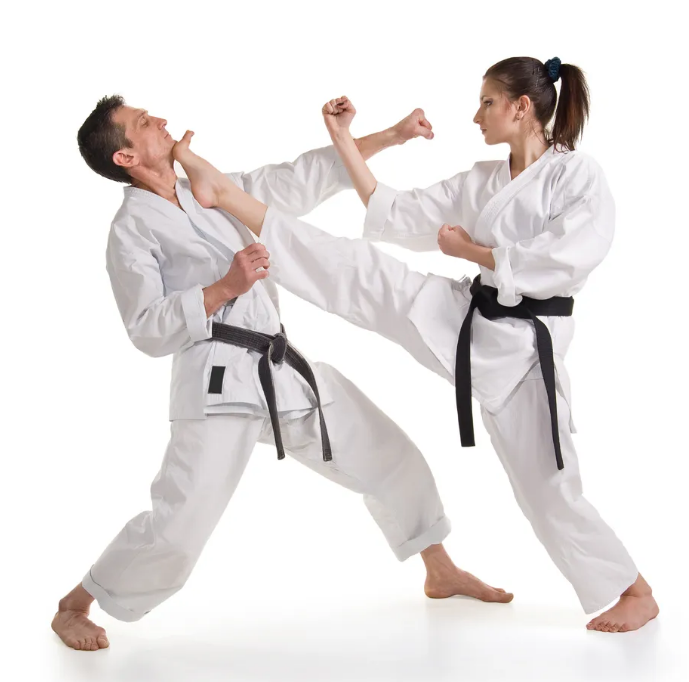Get to understand the history, similarities between Taekwondo and Karate. The basis of comparison includes name derivation, alternative name, regulating bodies, main features, training, and styles among others.
Main Features Of Taekwondo

- Kicking techniques are given more emphasis in Taekwondo, though punching, blocking with parries and takedowns are also part of the training.
- The Taekwondo Olympic event feature a one-on-one competition. It includes four weight classes each for men and women and involves a single elimination tournament for gold and silver medal awards.
- Taekwondo training is well-rounded and involves learning blocks, punches, open-handed strikes, take-downs, throws and joint locks.
- The common regulating organizations for taekwondo include: World Taekwondo Federation (WTF), International Taekwondo Federation (ITF) and American Taekwondo Association (ATA)
- Taekwondo training is well-rounded and involves learning blocks, punches, open-handed strikes, take-downs, throws and joint locks.
Main Features Of Karate

- As a striking art, more emphasis is on open-handed techniques, that is, punching, takedowns, parries and kicking with use of the knees and elbows.
- Karate World Championships has three main events: Para-karate (competitions for athletes with disabilities), Kumite (one-on-one competition) and Kata (demonstration of kata form).
- Karate training entails chokes, throws, take-downs, grappling, ground-fighting techniques and joint manipulation.
- The common regulatory organizations include: Japan Karate Federation, World Karate Federation (WKF), World Seido Karate Organization, European Kyokushin Karate Organization and USA National Karate DO.
- Karate training entails chokes, throws, take-downs, grappling, ground-fighting techniques and joint manipulation.
Difference Between Taekwondo And Karate In Tabular Form
| BASIS OF COMPARISON | TAEKWONDO | KARATE |
| Description | Taekwondo also referred to as Tae Kwon Do is a Korean martial art, characterized by its emphasis on head-height kicks, jumping and spinning kicks and fast kicking techniques. | Karate also referred to as Karate-Do, is unarmed martial-arts discipline employing kicking, striking and defensive blocking with arms and legs. |
| History | Taekwondo as an art has existed in Korea for over 2300 years. It began as a defense martial art called ‘’Subak’’ or ‘’Taekkyeon’’. The three rival kingdoms called Goguryeo, Silla and Baekje in 57 BC to 668 BC trained their men in unarmed combat. Subak was the most popular and the best known of the Subak styles was called Taekkyeon. | Karate developed hundreds of years ago on the Japan Island of Okinawa. Japan forcibly occupied Okinawa in 1600 and confiscated all weapons. Okinawans fought back with their bare hands and feet. Those striking, blocking and kicking methods were refined and karate was born. |
| Derivation | Taekwondo is derived from Korean words –“tae” meaning foot, “kwon” meaning fist and “do” meaning way or discipline. Therefore taekwondo literally means “the way of the foot and fist”. | The word karate means “empty hands’’. The word possibly explains that karate originated as a system of self-defense which relied on effective use of unarmed body. |
| Alternative Name | Taekwon-Do Tae Kwon-Do Tae Kwon Do | Karate-Do |
| Olympic Event | Taekwondo is an Olympic sport. | Karate is not an Olympic sport. |
| Instructor’s Title | Sa Bum Nim is the common title for taekwondo instructor. | Sensei is the common title for instructor. |
| Uniform | Taekwondo uniform is referred to as dobok. | Karate uniform is referred to as ‘gi’. |
| Title for the practitioner | Taekwondoin. | Karateka. |
| Notable Features | The most common feature of taekwondo is fast kicking. | The most common features of karate are strong punches, kicks, takedowns and blocks. |
| Typical Style | Arms together. | Arms straight against the torso, hands just below the waist and bow executed by bending the torso down while keeping the eyes on the opponent. |
| Forms | The pre-arranged sequence of techniques generally referred to as forms, are called poomsae in Taekwondo. | The pre-arranged sequence of techniques generally referred to as forms are known as Kata in Karate. |
| Training | Taekwondo training is well-rounded and involves learning blocks, punches, open-handed strikes, take-downs, throws and joint locks. | Karate training entails chokes, throws, take-downs, grappling, ground-fighting techniques and joint manipulation. |
| Regulating bodies | The common regulating organizations for taekwondo include: World Taekwondo Federation (WTF). International Taekwondo Federation (ITF). American Taekwondo Association (ATA). | The common regulatory organizations include: Japan Karate Federation (JKF) World Karate Federation (WKF) World Seido Karate Organization European Kyokushin Karate Organization USA National Karate DO |
Similarities Between Taekwondo And Karate
- Both karate and Taekwondo are taught in a dojo (dojang in korea) and have similar uniforms. The uniform is generally white and made from a light cotton material to promote mobility and flexibility.
- Both Taekwondo and karate still holds some of the traditional norms whereby they do not teach use of weapons.
- Both Karate and Taekwondo emphasizes respect towards teachers and fellow students.
- The techniques used in both Karate and Tae kwon Do are part of a set of choreographed forms. The beginners start by learning the basic fundamental rules and moves. The choreographed forms in Karate are referred to as “Kata” whereas in Taekwondo they are referred to as ‘’ poomsae’’.
- Both Taekwondo and Karate can help an individual to develop good qualities such as patience, self-discipline and self-confidence.
- Both Taekwondo and Karate are good for kids. They help kids to avoid issues like obesity and increase their fitness together with improving their cardiovascular health.
Wooh! very interesting piece of writing, I have been having confusion between Karate and Taekwondo. Now the confusion is very much settled.
I love the history part of the article. It’s perfectly derived.
Are both Karate and Taekwondo, Olympic Sports ?
Between Taekwondo and Karate, which is best for children?
How long does one train to become a karataker ?
Between Taekwondo and Karate, Which is more dangerous for kids??